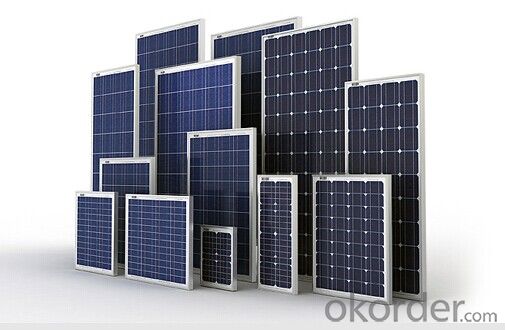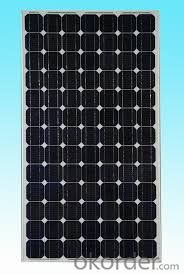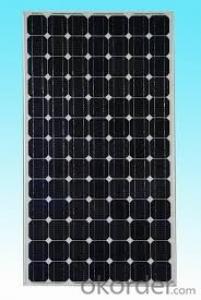30W Small Monocrystalline Solar Panel With Good Quality CNBM
- Loading Port:
- Qingdao
- Payment Terms:
- TT OR LC
- Min Order Qty:
- 10 set
- Supply Capability:
- 300000 set/month
OKorder Service Pledge
OKorder Financial Service
You Might Also Like
Mini Monocrystalline Solar Panel with 30W


Monocrystalline Solar Modules
We offers a range of small, medium and large monocrystalline solar modules, designed for a range of requirements.
Specifications:
Tolerance | +/- 3% |
Cell | Monocrystalline silicon solar cells |
N0. of Cells | 72 (12 x 6) |
Dimension of Modules (mm) | 1581 x 809 x 40 |
Weight (kg) | 15.5 |
Limits:
Operating Temperature | -40~+85? |
Storage Temperature | -40~+85? |
Maximum System Voltage | 1000 VDC max. |
Hail Impact | Diameter of 28mm with impact speed of 86km/h |
Temperature and Coefficients:
NOCT | 48C+/-2? |
Voltage temperature coefficient (%/K) | -0.34 |
Current temperature coefficient (%/K) | 0.09 |
Power temperature coefficient (%/K) | -0.37 |
Characteristics:
Model: | SGM-160D | SGM-165D | SGM-170D |
Max-power voltage Vmp (V) | 34.5 | 35.4 | 35.8 |
Max-power current Imp (A) | 4.64 | 4.66 | 4.75 |
Open-circuit voltage Voc (V) | 41.75 | 43.6 | 43.32 |
Short-Circuit Current Isc (A) | 5.32 | 5.08 | 5.38 |
Max-power Pm(W) | 160 | 165 | 170 |
Model: | SGM-175D | SGM-180D | SGM-185D |
Max-power voltage Vmp (V) | 36.1 | 36.2 | 36.2 |
Max-power current Imp (A) | 4.85 | 4.97 | 5.11 |
Open-circuit voltage Voc (V) | 43.68 | 43.8 | 44.8 |
Short-Circuit Current Isc (A) | 5.49 | 5.48 | 5.51 |
Max-power Pm(W) | 175 | 180 | 185 |
STC: Irradiance 1000W/m2, Module temperature 25?, AM=1.5
Monocrystalline Solar Panels Specifications Range
Maximum Power (Pm) | Dimension | Weight | Operating Voltage (Vmp) | Operating Current (Imp) | Open Circuit Voltage (Voc) | Short Circuit Current (Isc) |
3W | 158x241x25mm | 0.5kg | 8.5V | 0.36A | 10.5V | 0.4A |
4W | 308x166x25mm | 0.77kg | 8.5V | 0.47A | 10.5V | 0.54A |
4W | 308.x166x25mm | 0.77kg | 16.8V | 0.24A | 21V | 0.27A |
5W | 296x215x25mm | 0.3kg | 16.8V | 0.48a | 21V | 0.54A |
10W | 286x406x25mm | 1.5kg | 16.8V | 0.59A | 21V | 0.66A |
12W | 286x406x25mm | 1.5kg | 16.8V | 0.71A | 21V | 0.8A |
14W | 286x541x25mm | 2kg | 16.8V | 0.83A | 21V | 0.96A |
16W | 286x541x25mm | 2kg | 17.2V | 0.93A | 21.5V | 0.99A |
18W | 296x541x25mm | 2.4kg | 18.8V | 1.07A | 21V | 1.2A |
20W | 296x641x25mm | 2.4kg | 17.2V | 1.15A | 21.5V | 1.24A |
24W | 541x451x25mm | 3.15kg | 16.8V | 1.14A | 21V | 1.56A |
26W | 541x451x25mm | 3.15kg | 17.2V | 1.51A | 21.5V | 1.63A |
30W | 296x966x25mm | 3.85kg | 16.8V | 1.78A | 21V | 2.03A |
36W | 541x641x35mm | 4.7kg | 16.8V | 2.14a | 21V | 2.4A |
40W | 541x641x35mm | 4.7kg | 17.2V | 2.33A | 21.5V | 2.5A |
55W | 1057x457x35mm | 6.6kg | 17.6V | 3.12A | 21.6V | 3.3A |
70W | 546x1196x35mm | 8.5kg | 16.8V | 4.15A | 21V | 4.7A |
75W | 546x1196x35mm | 8.5kg | 17.2V | 4.36A | 21.5V | 4.8A |
80W | 546x1196x35mm | 8.5kg | 17.6V | 4.55A | 21.6V | 4.9A |
110W | 1066x811x40mm | 11.8kg | 17.6V | 6.25A | 21.6V | 6.6A |
150W | 1066x811x40mm | 14kg | 34.4V | 4.36A | 43.2V | 4.7A |
- Q:im aware i dont fully understand. but with what i do. if P = iv, and current changes with voltage, whats the point of changing either. if in any cicumstance, you end up with the same wattage, how does changing either effect a solar setup. (2v panel vs 24v)thanks in advance. explain in laymans if you can.
- The choice of solar panel voltage comes down more to what the panels will be connected to. You're right that power can remain the same at the different voltages. Higher input (panel) voltages are sometimes used in inverter systems to reduce the effect of voltage draw-down. 2v panels (about 20v open circuit) work well for charging 2v batteries, connected in parallel, through a charge controller. For use of a grid-tie inverter, higher input voltages are sometimes used to reduce the effects of draw-down. You want to select and wire (parallel vs. series) your panels based on the input voltage requirement of the load, whatever it may be.
- Q:Can solar panels be installed on a factory or manufacturing plant?
- Yes, solar panels can be installed on a factory or manufacturing plant. In fact, many industrial facilities are increasingly adopting solar energy to meet their power needs and reduce their carbon footprint. The large roof areas and open spaces available in factories make them ideal locations for solar panel installations, enabling businesses to generate clean and renewable energy on-site while saving on electricity costs.
- Q:Are solar panels recyclable?
- Yes, solar panels are recyclable. The majority of their components, such as glass, aluminum, and silicon, can be recycled and reused in the manufacturing of new solar panels.
- Q:Can solar panels be used for powering water treatment plants?
- Yes, solar panels can be used for powering water treatment plants. Solar energy can be harnessed to generate electricity, which can then be used to power the various processes and equipment involved in water treatment plants. This environmentally-friendly approach helps reduce reliance on fossil fuels and contributes to sustainable water management practices.
- Q:DIY, buying solar panels, room is barely 200 sq. ft. have a 5000 btu air conditioner, how many watts do I need, thinking of buying 75 watt solar panels, have space on the roof.
- It may cost you about $650, you can also learn building it yourself so you can save much money...
- Q:Can solar panels be used for powering electric lawnmowers or gardening tools?
- Yes, solar panels can be used to power electric lawnmowers or gardening tools. By connecting the solar panels to a battery storage system, the energy collected from the sun can be stored and used to power these tools, providing a sustainable and environmentally friendly alternative to traditional power sources.
- Q:how much energy does solar panels save you? (like a month, year, etc)
- It depends on the size of the solar panels and the intensity of the solar-light. So, there's difference in every place. It's impossible to answer unless there's detail of panel size, panel quantities, average rainfall, average solar days, etc.
- Q:How do solar panels affect the overall comfort of a building?
- Solar panels can positively impact the overall comfort of a building by reducing energy costs and improving indoor temperature control. They generate clean and renewable electricity, which can power various systems such as heating, ventilation, and air conditioning (HVAC) units. This helps to regulate the indoor temperature more efficiently, leading to a more comfortable environment for occupants. Moreover, solar panels can also reduce reliance on the grid, ensuring a more reliable energy supply and enhancing the comfort and stability of the building.
- Q:Can solar panels be used to power a school?
- Yes, solar panels can definitely be used to power a school. Solar panels convert sunlight into electricity, which can be used to power various electrical systems within a school, including lighting, heating/cooling systems, computers, and other appliances. By harnessing solar energy, schools can reduce their dependence on traditional sources of electricity and contribute to a more sustainable and eco-friendly environment.
- Q:How much solar energy does a 2m by a 3m solar panel convert to energy on a sunny day? Assume that the solar cells are 30% efficient.I'm not looking for the answer so much as I need an explanation o how to solve this type of problem... Thanks!!
- You have the area of the solar panel. You know their efficiency. What you need to know now is the energy (per area) delivered by the sun. The energy delivered by the sun can be found on the internet. Earth ,43 – ,32 W/m? (wikipedia) That is offcourse for your solar panels perpendicular to the ray's of the sun. If they are under an angle you should see what the area of the projecton of your solar panel is on a plane perpendicular to the ray's of the sun. So know you have the intensity W/m? and an area (or effective area). Here you go the energy deliverd by the sun. And 30% of it is what you get out of your panels.
1. Manufacturer Overview |
|
|---|---|
| Location | |
| Year Established | |
| Annual Output Value | |
| Main Markets | |
| Company Certifications | |
2. Manufacturer Certificates |
|
|---|---|
| a) Certification Name | |
| Range | |
| Reference | |
| Validity Period | |
3. Manufacturer Capability |
|
|---|---|
| a)Trade Capacity | |
| Nearest Port | |
| Export Percentage | |
| No.of Employees in Trade Department | |
| Language Spoken: | |
| b)Factory Information | |
| Factory Size: | |
| No. of Production Lines | |
| Contract Manufacturing | |
| Product Price Range | |
Send your message to us
30W Small Monocrystalline Solar Panel With Good Quality CNBM
- Loading Port:
- Qingdao
- Payment Terms:
- TT OR LC
- Min Order Qty:
- 10 set
- Supply Capability:
- 300000 set/month
OKorder Service Pledge
OKorder Financial Service
Similar products
New products
Hot products
Related keywords




























